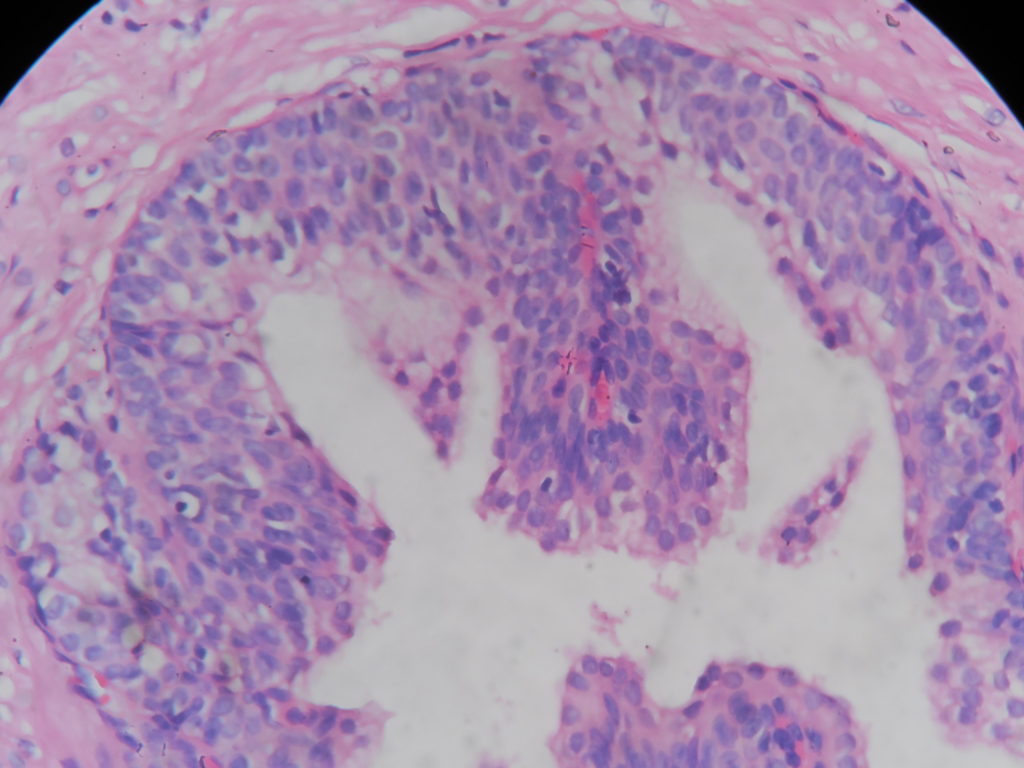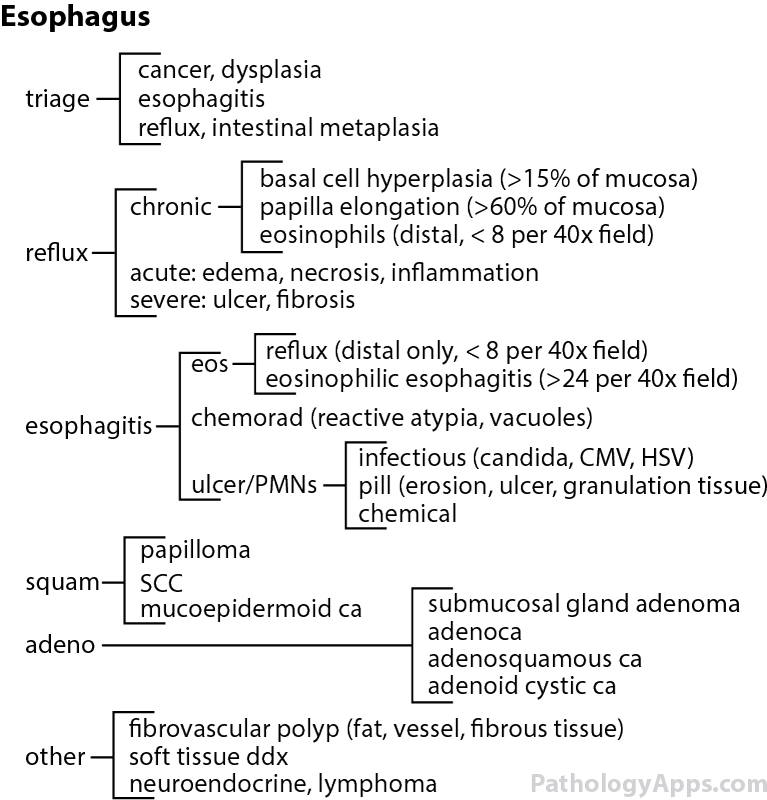What Is Basal Cell Hyperplasia Esophagus
What Is Basal Cell Hyperplasia Esophagus - Basal cell hyperplasia is defined as more than 15% of the. Hyperplasia also complicates other forms of esophagitis so that it is not specific for gerd. Basal cell hyperplasia (bch) scoring system. Increased mitoses, slight enlargement of basal and suprabasal nuclei, and prominent nucleoli and hyperchromatism are features often associated with true basal cell. Human esophageal endoscopic biopsy specimens stained with hematoxylin & eosln were evaluated for basal cell content. Basal cell hyperplasia is a reversible change that disappears with treatment. The information here is meant to help you understand medical terms you might find in your pathology report after an esophageal biopsy.
Basal cell hyperplasia (bch) scoring system. Increased mitoses, slight enlargement of basal and suprabasal nuclei, and prominent nucleoli and hyperchromatism are features often associated with true basal cell. Basal cell hyperplasia is a reversible change that disappears with treatment. Human esophageal endoscopic biopsy specimens stained with hematoxylin & eosln were evaluated for basal cell content. The information here is meant to help you understand medical terms you might find in your pathology report after an esophageal biopsy. Hyperplasia also complicates other forms of esophagitis so that it is not specific for gerd. Basal cell hyperplasia is defined as more than 15% of the.
Basal cell hyperplasia is defined as more than 15% of the. The information here is meant to help you understand medical terms you might find in your pathology report after an esophageal biopsy. Human esophageal endoscopic biopsy specimens stained with hematoxylin & eosln were evaluated for basal cell content. Basal cell hyperplasia is a reversible change that disappears with treatment. Hyperplasia also complicates other forms of esophagitis so that it is not specific for gerd. Basal cell hyperplasia (bch) scoring system. Increased mitoses, slight enlargement of basal and suprabasal nuclei, and prominent nucleoli and hyperchromatism are features often associated with true basal cell.
Basal cell hyperplasia is associated with decreased BMP signaling in a
Basal cell hyperplasia (bch) scoring system. Human esophageal endoscopic biopsy specimens stained with hematoxylin & eosln were evaluated for basal cell content. The information here is meant to help you understand medical terms you might find in your pathology report after an esophageal biopsy. Increased mitoses, slight enlargement of basal and suprabasal nuclei, and prominent nucleoli and hyperchromatism are features.
Esophageal epithelium with severe basal layer hyperplasia, papillary
Increased mitoses, slight enlargement of basal and suprabasal nuclei, and prominent nucleoli and hyperchromatism are features often associated with true basal cell. Basal cell hyperplasia is a reversible change that disappears with treatment. Basal cell hyperplasia is defined as more than 15% of the. Basal cell hyperplasia (bch) scoring system. Hyperplasia also complicates other forms of esophagitis so that it.
Histopathology in PE. ( ) Esophageal mucosa showing basal cell
Human esophageal endoscopic biopsy specimens stained with hematoxylin & eosln were evaluated for basal cell content. Basal cell hyperplasia (bch) scoring system. Increased mitoses, slight enlargement of basal and suprabasal nuclei, and prominent nucleoli and hyperchromatism are features often associated with true basal cell. Basal cell hyperplasia is a reversible change that disappears with treatment. Basal cell hyperplasia is defined.
Expand All Collapse All
Basal cell hyperplasia (bch) scoring system. Human esophageal endoscopic biopsy specimens stained with hematoxylin & eosln were evaluated for basal cell content. Hyperplasia also complicates other forms of esophagitis so that it is not specific for gerd. Basal cell hyperplasia is defined as more than 15% of the. Basal cell hyperplasia is a reversible change that disappears with treatment.
Distal esophageal squamous mucosa showing basal cell hyperplasia (>15
Human esophageal endoscopic biopsy specimens stained with hematoxylin & eosln were evaluated for basal cell content. Basal cell hyperplasia is defined as more than 15% of the. Hyperplasia also complicates other forms of esophagitis so that it is not specific for gerd. Basal cell hyperplasia (bch) scoring system. The information here is meant to help you understand medical terms you.
Basal cell hyperplasia >50 of the epithelial thickness (H& X200
Basal cell hyperplasia is defined as more than 15% of the. Basal cell hyperplasia is a reversible change that disappears with treatment. Increased mitoses, slight enlargement of basal and suprabasal nuclei, and prominent nucleoli and hyperchromatism are features often associated with true basal cell. Human esophageal endoscopic biopsy specimens stained with hematoxylin & eosln were evaluated for basal cell content..
Basal Cell Hyperplasia Prostate
Basal cell hyperplasia is a reversible change that disappears with treatment. Basal cell hyperplasia (bch) scoring system. The information here is meant to help you understand medical terms you might find in your pathology report after an esophageal biopsy. Increased mitoses, slight enlargement of basal and suprabasal nuclei, and prominent nucleoli and hyperchromatism are features often associated with true basal.
Basal cell hyperplasia prostate Histopathology.guru
Human esophageal endoscopic biopsy specimens stained with hematoxylin & eosln were evaluated for basal cell content. The information here is meant to help you understand medical terms you might find in your pathology report after an esophageal biopsy. Basal cell hyperplasia (bch) scoring system. Basal cell hyperplasia is defined as more than 15% of the. Basal cell hyperplasia is a.
esophagus pathology
Increased mitoses, slight enlargement of basal and suprabasal nuclei, and prominent nucleoli and hyperchromatism are features often associated with true basal cell. The information here is meant to help you understand medical terms you might find in your pathology report after an esophageal biopsy. Human esophageal endoscopic biopsy specimens stained with hematoxylin & eosln were evaluated for basal cell content..
Basal cell hyperplasia prostate Histopathology.guru
Human esophageal endoscopic biopsy specimens stained with hematoxylin & eosln were evaluated for basal cell content. Hyperplasia also complicates other forms of esophagitis so that it is not specific for gerd. Basal cell hyperplasia is a reversible change that disappears with treatment. Increased mitoses, slight enlargement of basal and suprabasal nuclei, and prominent nucleoli and hyperchromatism are features often associated.
Increased Mitoses, Slight Enlargement Of Basal And Suprabasal Nuclei, And Prominent Nucleoli And Hyperchromatism Are Features Often Associated With True Basal Cell.
Basal cell hyperplasia is a reversible change that disappears with treatment. Basal cell hyperplasia is defined as more than 15% of the. Basal cell hyperplasia (bch) scoring system. Hyperplasia also complicates other forms of esophagitis so that it is not specific for gerd.
The Information Here Is Meant To Help You Understand Medical Terms You Might Find In Your Pathology Report After An Esophageal Biopsy.
Human esophageal endoscopic biopsy specimens stained with hematoxylin & eosln were evaluated for basal cell content.









